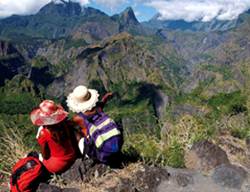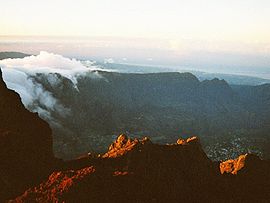Salazie is the easiest to access and has several cascading waterfalls. Hellbourg the little picturesque town at the bottom of the caldera Mafate is only accessible by foot or helicopter and is famous for its hiking trails, Cilaos is excellent for cycling and hiking trails as well as canyonning. It also has thermal baths and wine farms.
Cirque de Salazie
 Located about 45 kilometres from Reunion's capital city of St-Denis, Cirque de Salazie is the largest and greenest of the island's three natural amphitheatres. This cirque is both rugged and beautiful, best described as a long, deep canyon, lined with more than 100 magnificent waterfalls and full of hills and valleys ripe for exploration.
Located about 45 kilometres from Reunion's capital city of St-Denis, Cirque de Salazie is the largest and greenest of the island's three natural amphitheatres. This cirque is both rugged and beautiful, best described as a long, deep canyon, lined with more than 100 magnificent waterfalls and full of hills and valleys ripe for exploration.
One of the most breathtaking sites of this cirque is the towering waterfall known as Le Voile de la Mariée, its many trickles of water said to resemble the tulle fabric of a wedding gown. Get your camera ready as you'll want to remember this sight for years to come!
Once you've hiked the hills and gone canyoning through Cirque de Salazie's steep gorges, you'll want to make a stop at the cosy village of Hell-Bourg. Hell-Bourg has been the recipient of France's coveted "most beautiful French villages" award. This enchanting little mountain town is Creole culture at its finest, boasting enchanting Creole houses and colourful flower gardens that simply delight the eye. Be sure to tour Mansion Folio, opened to the general public, and providing an excellent example of Creole architecture and Salazie lifestyle. This town was also once famous for its thermal springs, not unlike neighbouring Cirque de Cilaos. Though the hot springs have disappeared, you can still visit the Hotel des Thermes in Hell-Bourg.
Finding a good time to explore Cirque de Salazie can be difficult at times as the area is often covered with fog and mist. However, if your schedule is flexible and you can find a sunny day, you'll be treated to some of the most amazing scenery on the island. As a matter of fact, most residents and seasoned travellers believe that this is indeed the most beautiful of all the cirques.
Cirque de Cilaos
 Reunion's dramatic Cirque de Cilaos is a natural wonder and visitors will love the memorable drive that leads them toward the stunning cirque, with all its twists and turns and numerous tunnels. But the sometimes nail-biting drive is well worth it! When you reach the cirque itself, you'll be treated to colourful fields of flowers, forests of unique indigenous trees, and soaring walls and pounding waterfalls that attract the most avid canyoners.
Reunion's dramatic Cirque de Cilaos is a natural wonder and visitors will love the memorable drive that leads them toward the stunning cirque, with all its twists and turns and numerous tunnels. But the sometimes nail-biting drive is well worth it! When you reach the cirque itself, you'll be treated to colourful fields of flowers, forests of unique indigenous trees, and soaring walls and pounding waterfalls that attract the most avid canyoners.
As a matter of fact, canyoning is quite a popular activity here and those serious about this outdoor pursuit travel here from many countries around the world to enjoy the best of the sport in this rugged yet pristine location.
For those who prefer to stay out of the water, many outfitters also offer rock climbing excursions for both beginning climbers and those with previous experience.
If canyoning or climbing are too strenuous, hiking and trekking are excellent ways to see this cirque. You'll find plenty of groomed hiking and mountain biking trails for energetic guests, ranging from easy to difficult, all offering wonderful photo opportunities. Visitors will travel up and down hills, past magnificent waterfalls, and perhaps stop at the village of Cilaos, where they can visit a vineyard or two to sample the excellent local wines, indicative of the fine French traditions of wine-making. The area is also known for its production of lentils - a grain that is plentifully used in delicious local dishes - and its beautiful embroidery work.
Be sure to include a walk up to La Roche Merveilleuse, where you can enjoy a view of the village and forests below, and don't forget to stop to see the thermal baths which, long ago, enticed those from the French mainland to come and make their home at the Cirque de Cilaos.
The Cirque de Cilaos is centrally located on the Island of Reunion and the name of this cirque or "caldera" is said to have its origins in the Malagasy word Tsilaosa, which means "the place one never leaves", Some believe, however, that the name resembles that of a runaway slave names Tsilaos, who took refuge here. The runaway slaves, otherwise known as "black-browns" believed that at Cilaos' high altitude, they were safe from capture. This proved not to be the case, most were apprehended, and many were killed in the process.
Cirque de Mafate
 Located in the northwest portion of Reunion Island, the beautiful Cirque de Mafate is totally surrounded by mountains. This rugged and wild cirque is the only one of the island's three natural amphitheatres that's accessible only on foot or by helicopter.
Located in the northwest portion of Reunion Island, the beautiful Cirque de Mafate is totally surrounded by mountains. This rugged and wild cirque is the only one of the island's three natural amphitheatres that's accessible only on foot or by helicopter.
The lack of automobiles and paved roads make this cirque a favourite destination for hikers as they can explore this unspoiled wilderness unencumbered by cars or tour buses. Hikers may reach Cirque de Mafate on roads that lead from the other two cirques, and once there, a number of mountain Gites (small cabins) are available to accommodate those who desire an overnight stay.
Arriving at Cirque de Mafate by helicopter is an awesome site and the choice for many Reunion Island guests who would prefer not to hike but would still like to see the interior of the cirque. Many companies offer helicopter rides to Cirque de Mafate from various parts of the island and advanced reservations are usually not necessary.
If you choose not to make the trek into the Cirque de Mafate or the idea of a helicopter ride is unsettling, you should consider taking a trip by automobile to the Maido Peak - a scenic overlook - where, at 2,200 meters, you can enjoy a bird's eye view of this cirque.
Cirque de Mafate was first settled in the 19th century by individuals referred to as "maroon" slaves; those who had escaped from their masters. Later, poor white labourers came and staked out claims here. Today, the cirque has one village, La Nouvelle, and a number of additional hamlets, located on flat-lands known as "ilets". All of the Cirque de Mafate is public property, managed by the local forestry service. Residents of the cirque rent from this government service at a very affordable price.
It takes a special kind of person to live here, as there is no main electrical supply. Residents use solar panels or diesel generators to avail themselves of power for lighting, cooking, and other daily activities. Water heaters are usually solar-powered as well. Any fuels used for electricity or heating must be flown in by helicopter. There are, however, small grocery stores that serve the other needs of both residents and travellers.